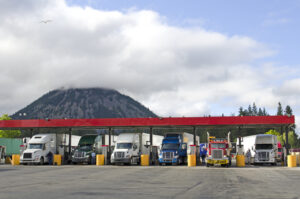
This past year was a roller coaster ride in terms of oil & gas fleet costs, with fuel prices rising to over $5.00 a gallon at one point. The fluctuating prices were due to a variety of factors, most notably the war in Ukraine and supply-chain issues, and proved a real headache for commercial fleet companies–fuel and gas account for roughly 60% of a typical company’s operating budget, making it the second-largest annual expense.
While owners and managers of commercial fleets obviously can’t control global events, there are ways to manage this expense and still turn a profit despite volatility in the market.
Below we’ll look at how oil prices affect fuel costs and vehicle purchasing decisions, as well as some strategies for combating the ever-fluctuating costs of oil and gas.
How Oil Prices Affect Fleet Operating Costs
It’s impossible to give an accurate answer to the question: “How much gas does a fleet consume each year?” But it’s safe to say—as everyone in the commercial industry learned this past year—that fleet operating costs can rapidly balloon when gas prices rise, no matter how much fuel your fleet consumes. Some companies saw their weekly fleet fuel costs nearly double, adding potentially millions of dollars to the annual ledger.
Vehicle maintenance, particularly engine oil, has experienced price increases as well, which has been exacerbated by supply-chain issues involving additives and “end-of costs” like plastics, cardboard, labels, paper and other packaging materials.
How Oil Prices Affect Automobile Purchasing Decisions
When oil & gas fleet costs are high or wildly unpredictable, it inevitably leads to a tough decision. Should you purchase a new truck or van for your commercial fleet, or pay for the maintenance needed to keep the older vehicles running?
When costs are low and there’s disposable funds available in the budget, it’s easier to account for the cost of financing the purchase of a new vehicle. But when fuel costs are as volatile as they currently are, the decision becomes much trickier.
That’s why it’s so important to develop a comprehensive strategy for combating–as best as you can–the whims of the global oil and gas market.
How to Combat Fluctuating Fleet Fuel Costs
As the owner or manager of a commercial fleet of vehicles, there are two main areas to focus on to combat the roller coaster of oil and gas prices: 1) driver behavior and 2) monitoring, maintenance and purchasing decisions.
Driver Behavior
- Eliminate Speeding/Aggressive Driving – Not only is speeding a safety hazard and illegal, but for every five miles that a driver travels over 50 miles an hour it costs the company $0.20 per gallon of gas, with that number rising the faster the vehicle is driven—traveling at 85mph uses 40% more fuel than at 70mph.Accelerating too quickly and braking too late can add to a vehicle’s fuel consumption as well.
- Cut Down on Idling Time – An idling truck runs about 0.8 gallons of fuel per hour, and is one of the biggest wastes of money in the commercial fleet industry. Luckily, most idle time can be eliminated by a conscientious driver. Stuck in a traffic jam, taking a break, talking on the phone in a parking lot or unloading a truck–these are all situations where the engine should not be running.
- Avoid Highways During Rush Hours – Stop-start driving is as fuel-intensive as it comes, and nothing sucks up gas like a slow-moving highway during rush hour—traffic congestion can reduce a vehicle’s fuel economy by as much as 40%, so have a driver plan ahead to avoid traveling at the most high-trafficked times.
- Moderate A/C Usage – Running the air conditioner puts extra load on the engine and can increase fuel consumption by up to 20%. Encourage A/C use only when the weather outside absolutely necessitates it.
Managerial Decisions
- Route Planning Software – If you’re looking for efficiency, route planning software can help guide your drives through their day in the most fuel-efficient way possible.
- Vehicle Monitoring – Utilizing fleet management software allows you to easily compare monthly fuel data and see how it affects your fleet operating costs in order to make more informed decisions.
- GPS Tracking – With a GPS device you can track driver behavior–including speeding, idling, hard braking and sudden stops–so that you can better optimize performance and minimize oil & gas fleet costs.
- Use the Right Lubricants and Tires – Lubricants can improve fuel efficiency, especially if you use greases that aren’t petroleum based, and a set of properly inflated tires can help you save a bundle in fuel costs as well.
- Purchase Electric Vehicles – With the price of electric trucks becoming economically viable, it’s been estimated that by the end of the decade it will be 50% cheaper to purchase and operate an electric vehicle than a diesel truck. That’s some savings worth saving for!
No matter how volatile the oil and gas market gets, by taking steps to reduce the wasteful use of gas and encourage fuel economy, you can better prepare your commercial fleet for fluctuating fuel prices.
And if you need emergency roadside service for your commercial fleet, including free gas delivery of up to three gallons, contact Best Roadside Service for a free quote!




